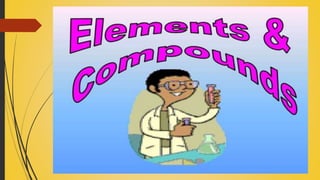
ELEMENTS AND COMPOUNDS.pptx
- 5. Activity 1 Water, “wat-er” you made of? Objectives In this activity, you should be able to: 1. carry out the electrolysis of water; 2. identify the components of water. Science LM pp. 29-31
- 6. ELEMENTS A chemical element or element is a species of atoms having the same number of protons in their atomic nuclei (i.e. the same atomic number, or Z). There are 118 elements that have been identified, of which the first 94 occur naturally on Earth with the remaining 24 being synthetic elements. There are 80 elements that have at least one stable isotope and 38 that have exclusively radioactive isotopes, which decay over time into other elements. Iron is the most abundant element (by mass) making up Earth, while oxygen is the most common element in the Earth's crust.
- 7. PERIODIC TABLE The periodic table is a tabular arrangement of the chemical elements, ordered by their atomic number (number of protons), electron configurations, and recurring chemical properties. This ordering shows periodic trends, such as elements with similar behaviour in the same column. It also shows four rectangular blocks with some approximately similar chemical properties. In general, within one row (period) the elements are metals on the left, and non-metals on the right.
- 8. Activity 2 The periodic table: It’s element-ary! Objectives In this activity, you should be able to: 1. Be familiar with the layout of the periodic table; 2. Know some information about the elements that may be found in the periodic table; and 3. Identify the group number an element it belongs to. Science LM pp. 33-35
- 9. There are many elements present in the food you eat —whether it is raw like banana or those processed like banana chips, biscuits, milk, and juice. These are mostly nutrients which the human body needs in order to function well. Some of these are calcium, magnesium, zinc, and selenium. The Nutrition Facts is a list of the different nutrients provided by the food product with their corresponding percentage share on the daily recommended dietary allowance
- 10. On the other hand, Ingredients give you a list of the materials that have been added to make the food product. These materials are the sources of the nutrients. These are the ones that are taken in by the body Minerals are important for your body to stay healthy. Your body uses minerals for many different jobs, including keeping your bones, muscles, heart, and brain working properly. Minerals are also important for making enzymes and hormones. There are two kinds of minerals: macrominerals and trace minerals. You need larger amounts of macrominerals. They include calcium, phosphorus, magnesium, sodium, potassium, chloride and sulfur. You only need small amounts of trace minerals. They include iron, manganese, copper, iodine, zinc, cobalt, fluoride and selenium.
- 11. Activity 3 The “matter” on labels Objectives In this activity, you should be able to: 1. Name elements that are listed in the Nutrition Facts of a food label; 2. Recognize that the elements listed in the Nutrition Facts are not added as the elements themselves; 3. Infer the food ingredient that could be the source of those listed elements; and 4. Recognize that most of these food ingredients are examples of compounds. Science PM pp. 36-38
- 12. FOOD GRADE Any ingredient added to food should be safe to eat in terms of quality and quantity NON FOOD GRADE substance then it should not be added to products that are meant to be ingested.
- 13. Activity 4 The iron-y of food fortification Objective: In this activity, you should be able to recover iron from a food product. Science LM pp. 42-43
- 14. Elements are part of almost anything around us — food, clothes, rocks, and even this paper you are currently reading from. Elements are said to be the building blocks of matter. They are like blocks that you can put together and build something new. When you build something new from these elements, you call them as compounds. Compounds are made up of elements. Elements are the simplest form of matter. Both elements and compounds are substances.